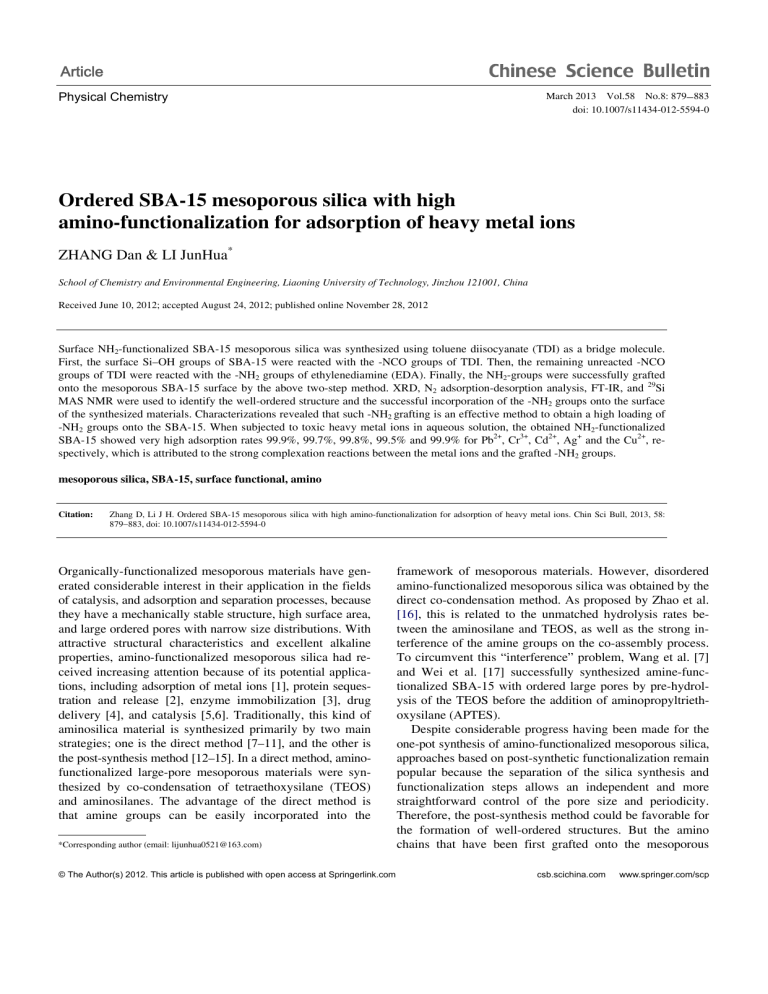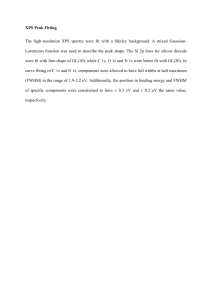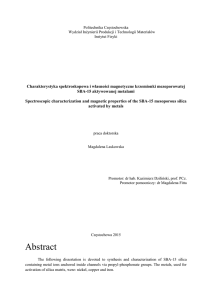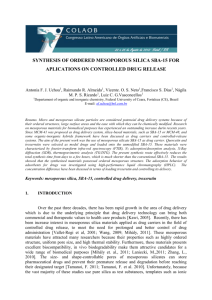
Article March 2013 Vol.58 No.8: 879883 doi: 10.1007/s11434-012-5594-0 Physical Chemistry Ordered SBA-15 mesoporous silica with high amino-functionalization for adsorption of heavy metal ions ZHANG Dan & LI JunHua* School of Chemistry and Environmental Engineering, Liaoning University of Technology, Jinzhou 121001, China Received June 10, 2012; accepted August 24, 2012; published online November 28, 2012 Surface NH2-functionalized SBA-15 mesoporous silica was synthesized using toluene diisocyanate (TDI) as a bridge molecule. First, the surface Si–OH groups of SBA-15 were reacted with the -NCO groups of TDI. Then, the remaining unreacted -NCO groups of TDI were reacted with the -NH2 groups of ethylenediamine (EDA). Finally, the NH2-groups were successfully grafted onto the mesoporous SBA-15 surface by the above two-step method. XRD, N2 adsorption-desorption analysis, FT-IR, and 29Si MAS NMR were used to identify the well-ordered structure and the successful incorporation of the -NH2 groups onto the surface of the synthesized materials. Characterizations revealed that such -NH2 grafting is an effective method to obtain a high loading of -NH2 groups onto the SBA-15. When subjected to toxic heavy metal ions in aqueous solution, the obtained NH2-functionalized SBA-15 showed very high adsorption rates 99.9%, 99.7%, 99.8%, 99.5% and 99.9% for Pb2+, Cr3+, Cd2+, Ag+ and the Cu2+, respectively, which is attributed to the strong complexation reactions between the metal ions and the grafted -NH2 groups. mesoporous silica, SBA-15, surface functional, amino Citation: Zhang D, Li J H. Ordered SBA-15 mesoporous silica with high amino-functionalization for adsorption of heavy metal ions. Chin Sci Bull, 2013, 58: 879883, doi: 10.1007/s11434-012-5594-0 Organically-functionalized mesoporous materials have generated considerable interest in their application in the fields of catalysis, and adsorption and separation processes, because they have a mechanically stable structure, high surface area, and large ordered pores with narrow size distributions. With attractive structural characteristics and excellent alkaline properties, amino-functionalized mesoporous silica had received increasing attention because of its potential applications, including adsorption of metal ions [1], protein sequestration and release [2], enzyme immobilization [3], drug delivery [4], and catalysis [5,6]. Traditionally, this kind of aminosilica material is synthesized primarily by two main strategies; one is the direct method [7–11], and the other is the post-synthesis method [12–15]. In a direct method, aminofunctionalized large-pore mesoporous materials were synthesized by co-condensation of tetraethoxysilane (TEOS) and aminosilanes. The advantage of the direct method is that amine groups can be easily incorporated into the *Corresponding author (email: lijunhua0521@163.com) © The Author(s) 2012. This article is published with open access at Springerlink.com framework of mesoporous materials. However, disordered amino-functionalized mesoporous silica was obtained by the direct co-condensation method. As proposed by Zhao et al. [16], this is related to the unmatched hydrolysis rates between the aminosilane and TEOS, as well as the strong interference of the amine groups on the co-assembly process. To circumvent this “interference” problem, Wang et al. [7] and Wei et al. [17] successfully synthesized amine-functionalized SBA-15 with ordered large pores by pre-hydrolysis of the TEOS before the addition of aminopropyltriethoxysilane (APTES). Despite considerable progress having been made for the one-pot synthesis of amino-functionalized mesoporous silica, approaches based on post-synthetic functionalization remain popular because the separation of the silica synthesis and functionalization steps allows an independent and more straightforward control of the pore size and periodicity. Therefore, the post-synthesis method could be favorable for the formation of well-ordered structures. But the amino chains that have been first grafted onto the mesoporous csb.scichina.com www.springer.com/scp 880 Zhang D, et al. Chin Sci Bull silica surface would form hydrogen bonding with the surface silanols, thereby preventing the further grafting of amino groups on the silica surface [18,19]. Zeng et al. [12] synthesized amine-functionalized mesoporous materials by a solvothermal process. Daehler et al. [14] synthesized surface amine-modified mesoporous silica via vapor-phase reactions. Much research has been focused on reducing amino-silanol and amino-amino interactions for the preparation of amino-functionalized SBA-15 with a high loading of amino groups [20,21]. It remains a challenge to synthesize amine-functionalized ordered mesoporous materials with large pores. In the present study, we proposed a novel method to synthesize aminofunctionalized SBA-15 (Figure 1). Herein, toluene diisocyanate (TDI) was employed as a “bridge” molecule whose one bridgehead group -NCO was used to link with an silanol group on the SBA-15 surface and the other was left to link with an amino group of ethylenediamine (EDA). Such a method should have a high linking efficiency because TDI is a very active molecule whose two -NCO groups can easily bond with -OH or -NH2 groups [22]. Meanwhile, the stepwise link can avoid the interactions between amino-silanol and amino-amino groups. Therefore, it would be useful to synthesize amino-functionalized SBA-15 with a high loading of amino groups. Moreover, the adsorption performance of the obtained material was investigated for the removal of heavy metal ions, Pb2+, Cr3+, Cd2+, Ag+ and Cu2+, from waste water. 1 Experimental 1.1 Preparation of surface NH2-functionalized SBA-15 mesoporous silica The preparation of amino-functionalized SBA-15 involved three steps. First, pure siliceous SBA-15 was prepared according to the reported literature [23,24]. Then, 1.0 g of assynthesized SBA-15 powder without templates was added Figure 1 Schematic illustration of the synthesis strategy of NH2-SBA-15. March (2013) Vol.58 No.8 into a mixed solution of 8.3 mL TDI and 16.7 mL of toluene. After stirring at 60°C for 5 h, the powder (denoted as T-SBA-15) was filtered and Soxhlet-extracted with CH2Cl2 for 48 h. At last, 1.0 g of dried T-SBA-15 powders was added into a mixed solution of 20.0 mL of ethylenediamine (EDA) and 20.0 mL of ether. The mixture was then stirred at 20°C for 24 h, and the final powder (denoted as NH2SBA-15) was filtered, Soxhlet-extracted and dried. 1.2 Adsorption experiments In a typical adsorption experiment, 20 mL of a single metal solution in a flask was mixed with 150 mg of adsorbent at room temperature. After stirring while covered for 24 h, the suspension was collected from the flask and centrifuged. The metal ion concentrations, both in the initial and final solutions, were determined by inductively-coupled plasmaatomic emission spectrometry (ICP-AES) on a TJA AtomScan16 spectrometer. 1.3 Characterization of materials The powder X-ray diffraction (XRD) patterns were recorded on a Bruker diffractometer using Cu K radiation. N2 adsorption-desorption isotherms were obtained on a Micromeritics Tristar 3000 pore analyzer at 77 K. 29Si MAS NMR experiments were performed on a Varian Infinityplus-300 spectrometer using a 7.5 mm probe under magicangle spinning: the resonance frequency was 79.5 MHz; the 90° pulse width was measured to be 4.8 s; a repetition time of 100 s for single-pulse experiments was used. FT-IR spectra were recorded on a Nicolet 470 Spectrometer with 4 cm1 resolution. Thermogravimetric analysis (TGA) studies were performed from 30 to 1000°C using a PerkinElmer TGA7 instrument, coupled with a mass spectrometer for evolved gas analysis, under a helium atmosphere. The heating rate was 20°C/min, and the helium flow was approximately 100 mL/min. Zhang D, et al. Chin Sci Bull March (2013) Vol.58 No.8 881 2 Results and discussion XRD patterns of three samples are presented in Figure 2. An intense peak (100) and two well-resolved small peaks (110) and (200) could be observed for all the samples, being indicative of well-ordered hexagonal mesoporous structures [12]. This result indicates that the mesoporous structure was not destroyed during the surface amino-functionalization process. N2 adsorption-desorption isotherms and pore diameter distributions of the samples were also studied (see Figures 3 and 4). Three samples possessed typical Type IV isotherms and H1 hysteresis loops, further confirming the characteristics of the mesoporous materials [25]. In Figure 4, the pore diameters of three samples displayed the sequence: SBA-15 (7.7 nm)>T-SBA-15 (6.6 nm)>NH2-SAB-15 (5.3 nm). The pore size distributions are calculated from the adsorption branch of the isotherm by the BJH method. This is an expected result, reflecting that the SBA-15 surface was indeed Figure 4 Pore size distribution of SBA-15, T-SBA-15 and NH2-SBA-15. Figure 2 Powder X-ray diffraction patterns of SBA-15, T-SBA-15 and NH2-SBA-15. stepwise organic-functionalized. For T-SBA-15, the surface Si–OH groups reacted with the -NCO groups of TDI, resulting in a pore size being smaller than that of SBA-15. As another -NCO group on the T-SBA-15 reacted with one -NH2 group of EDA, the pore size of NH2-SBA-15 was smaller than that of T-SBA-15. At the same time, all three samples have a narrow pore size distribution, indicating that the mesoporous surfaces of T-SBA-15 and NH2-SBA-15 have a uniformly functional surface coating. FT-IR spectra of SBA-15, T-SBA-15 and NH2-SBA-15 were investigated (Figure 5). In the spectrum of the TSBA-15 sample, an adsorption peak at 2280 cm1 attributable to the -NCO group of TDI could be observed [26]. This finding suggests that one end of the TDI molecules had been grafted onto the SBA-15 surface. For the NH2-SBA-15 sample, the peak at 2280 cm1 disappeared, to be replaced by two new adsorptions at 3186 and 3385 cm1 being Figure 3 N2 adsorption and desorption isotherms of SBA-15, T-SBA-15 and NH2-SBA-15. Figure 5 FT-IR spectra of SBA-15, T-SBA-15 and NH2-SBA-15. 882 Zhang D, et al. Chin Sci Bull attributable to the -NH2 groups of EDA [27]. These results indicated that EDA could be one-end grafted onto the SBA-15 surface using the TDI molecules as a “bridge”. The concentration of free amine groups on the surface of NH2SBA-15 was determined by the acid titration method. The result showed that the concentration of free amine groups for NH2-SBA-15 was 0.00264 mol/g. 29 Si MAS NMR was used to determine the degree of TDI grafting on the SBA-15 surface. Figure 6 shows the 29Si MAS NMR spectra of two of the three samples studied. The corresponding relative peak areas in 29Si MAS NMR spectra are summarized in Table 1. Therein, Q4, Q3, Q3′ and Q2 respectively represent the silicon atom environments of (SiO)4Si, (SiO)3SiOH, (SiO)3SiOTDI and (SiO)2Si(OH)2, in which (SiO)3SiOTDI (Q3′) indicates the link between the TDI molecule and the Si–OH groups of (SiO)3SiOH (Q3). It is well known that the transformation of Si–OH groups into Si–OC would result in the silicon atom undergoing a chemical shift toward the low field [28]. Nevertheless, in the 29Si MAS NMR spectra of T-SBA-15, no new peaks appeared as compared with that of SBA-15. Moreover, the Q3 peak was no longer present. The reason for this result is expected to be that the transformation of (SiO)3SiOH (Q3) into (SiO)3SiOTDI (Q3′) was virtually complete, and the Q3′ peak appeared at the position well approximate to that of Q4. Through data fitting in Table 1, it was found that both of SBA-15 and T-SBA-15 had almost equal (SiO)2Si(OH)2 contents. This might be explained by the reported conclusion that it is difficult to organically functionalize the Si–OH groups of (SiO)2Si(OH)2 [16] because of the strong hydrogen-bonding interaction between the geminate Si–OH groups of (SiO)2Si(OH)2. Also in Table 1, the percent contents of surface Si–OH groups were found to be 57.4% for SBA-15 and only 13.2% for TDI-SBA-15, indicating that the high degree of TDI grafting on the SBA-15 surface was realized. Figure 7 shows the TG analysis curves for SBA-15, TSBA-15 and NH2-SBA-15. For all of these samples, a slight weight loss was observed below 200°C, which is ascribed to residual water. In addition, SBA-15 shows a slight weight loss between 200 and 600°C owing to the condensation reaction between the Si–OH groups. In contrast, both T-SBA15 and NH2-SBA-15 exhibited considerable weight losses between 200 and 300°C, which is considered to be caused by decomposition of the organic component. And, the weight loss of NH2-SBA-15 was (19.9%), which is 1.32 times (15.1%) that of T-SBA-15, in good agreement with the moTable 1 March (2013) Vol.58 No.8 lecular weight ratio 1.33 of (TDI+EDA) to TDI. Therefore, it could be concluded that each TDI molecule was grafted to the SBA-15 surface via one head group, and subsequently EDA was one-head grafted with the other head group of TDI. The NH2-functionalized SBA-15 exhibited a unique affinity toward heavy metal ions. Table 2 shows the metal ion concentrations of simulated wastewater before and after adsorption by SBA-15, T-SBA-15 and NH2-SBA-15. It can be seen that the SBA-15 adsorbent scarcely removed the heavy metal ions, Pb2+, Cr3+, Cd2+, Ag+ and Cu2+, from the wastewater. After adsorption by T-SBA-15, the metal ion concentration decreased slightly. In contrast, the NH2-SBA15 adsorbent efficiently removed the heavy metal ions under the same conditions. The T-SBA-15 is able to adsorb some heavy metal ions because of the acylamide bonds after the surface Si–OH groups of SBA-15 were reacted with one -NCO group of TDI. For the NH2-SBA-15 adsorbent, the significant concentration changes are indeed attributed to the complexation reactions that occur between the metal ions and the grafted NH2- groups. 3 Conclusion In summary, well-ordered surface NH2-functionalized mesoporous silica SBA-15 was readily synthesized using a novel and effective method. This method employed TDI as the bridge molecule for this NH2-functionalization, and included the following remarkable advantages: (1) preventing amino- Figure 6 29 Si MAS NMR spectra of SBA-15 and T-SBA-15. Relative peak areas (%) in 29Si MAS NMR Spectra of SBA-15 and T-SBA-15 Samples SBA-15 /relative peak area Q2 Q3 Q4 92.7/6.8% 102.4/44.2% T-SBA-15 93.1/6.6% a) Represents the percent content of surface Si–OH groups. Q3′+Q4 (2Q2+Q3)a) 110.0/49.0% 57.4% 109.1/93.4% 13.2% Zhang D, et al. Chin Sci Bull March (2013) Vol.58 No.8 7 8 9 10 11 12 Figure 7 TGA thermograms of SBA-15, T-SBA-15 and NH2-SBA-15. Table 2 Concentrations of heavy metal ions in water before and after adsorbed (unit: mg/L) Solution Before adsorbed After adsorbed by SBA-15 After adsorbed by T-SBA-15 After adsorbed by NH2-SBA-15 Adsorption rate on NH2-SBA-15 Pb2+ 9.79 Cr3+ 9.12 Cd2+ 10.13 Ag+ 9.81 Cu2+ 9.57 9.73 9.12 10.01 9.72 9.49 7.59 8.03 8.32 8.16 8.01 0.011 0.025 0.019 0.052 0.008 99.9% 99.7% 99.8% 99.5% 99.9% silanol and amino-amino interactions occurring; (2) preventing destruction of the mesoporous structure; (3) providing high functional efficiency. As expected, a high loading of amino groups on the SBA-15 surface was realized. The obtained material showed a high adsorption capacity for heavy metal ions due to the strong complexation reactions that occur between metal ions and the grafted -NH2 groups. 1 2 3 4 5 6 Liu A M, Hidajat K, Kawi S, et al. A new class of hybrid mesoporous materials with functionalized organic monolayers for selective adsorption of heavy metal ions. Chem Commun, 2000, 13: 1145–1146 Han Y J, Stucky G D, Butler A. Effect of hexafluoroisopropanol on the thermodynamics of peptide secondary structure formation. J Am Chem Soc, 1999, 121: 9879–9880 Descalzo A B, Jimenez D, Marcos M D, et al. A new approach to chemosensors for anions using MCM-41 grafted with amino groups. Adv Mater, 2002, 14: 966–969 Balas F, Manzano M, Horcajada P, et al. Confinement and controlled release of bisphosphonates on ordered mesoporous silica-based materials. J Am Chem Soc, 2006, 128: 8116–8117 Sharma K K, Asefa T. Efficient bifunctional nanocatalysts by simple postgrafting of spatially isolated catalytic groups on mesoporous Materials. Angew Chem Int Ed, 2007, 46: 2879–2882 Macquarrie D J, Jackson D B. Aminopropylated MCMs as base catalysts: A comparison with aminopropylated silica. Chem Commun, 1997, 18: 1781–1782 13 14 15 16 17 18 19 20 21 22 23 24 25 26 27 28 883 Wang X G, Lin K S K, Chan J C C, et al. Preparation of ordered large pore SBA-15 silica functionalized with aminopropyl groups through one-pot synthesis. Chem Commun, 2004, 23: 2762–2763 Zhang L, Liu J, Yang J, et al. Direct synthesis of highly ordered amine-functionalized mesoporous ethane-silicas. Microporous Mesoporous Mat , 2008, 109: 172–183 Zhang W H, Lu X B, Xiu J H, et al. Synthesis and characterization of bifunctionalized ordered mesoporous materials. Adv Funct Mater, 2004, 14: 544–552 Chong A S M, Zhao X S. Functionalization of SBA-15 with APTES and characterization of functionalized materials. J Phys Chem B, 2003, 107: 12650–12657 Mouawia R, Mehdi A, Reye C, et al. Bifunctional ordered mesoporous materials direct synthesis and study of the distribution of two distinct functional groups in the pore channels. J Mater Chem, 2008, 18: 4193–4203 Zeng W, Qian X F, Zhang Y B, et al. Organic modified mesoporous MCM-41 through solvothermal process as drug delivery system. Mater Res Bull, 2005, 40: 766–772 Zheng S, Gao L, Guo J K. Synthesis and characterization of copper(II)phenanthroline complex grafted organic groups modified MCM-41. Mater Chem Phys, 2001, 71: 174–178 Daehler A, Boskovic S, Michelle L, et al. Postsynthesis vapor-phase functionalization of MCM-48 with hexamethyldisilazane and 3aminopropyldimethylethoxylsilane for bioseparation applications. J Phys Chem B, 2005, 109: 16263–16271 Ritter H, Nieminen M, Karppinen M, et al. A comparative study of the functionalization of mesoporous silica MCM-41 by deposition of 3-aminopropyltrimethoxysilane from toluene and from the vapor phase. Microporous Mesoporous Mat, 2009, 121: 79–83 Chong A S M, Zhao X S, Kustedjo A T, et al. Functionalization of large-pore mesoporous silicas with organosilanes by direct synthesis. Microporous Mesoporous Mat, 2004, 72: 33–42 Wei Q, Nie Z R, Hao Y L, et al. Effect of synthesis conditions on the mesoscopical order of mesoporous silica SBA-15 functionalized by amino groups. J Sol-Gel Sci Technol, 2006, 39: 103–109 Hicks J C, Jones C W. Controlling the density of amine sites on silica surfaces using benzyl spacers. Langmuir, 2006, 22: 2676–2681 Perrin C L. Gipe P K. Rotation, solvation, and hydrogen bonding of aqueous ammonium ion. J Am Chem Soc, 1986, 108: 1088–1089 Kanan S M, Tze W T Y, Tripp C P. Method to double the surface concentration and control the orientation of adsorbed (3-aminopropyl) dimethylethoxysilane on silica powders and glass slides. Langmuir, 2002, 18: 6623–6227 Mckittrick M W, Jones C W. Toward single-site functional materials: Preparation of amine-functionalized surfaces exhibiting site-isolated behavior. Chem Mater, 2003, 15: 1132–1139 Inoue K, Ono Y, Kanekiyo Y, et al. Facile preparation of robust organic gels by cross-link of a sugar-integrated gelator by toluene-2,4diisocyanate. Chem Lett, 1999, 28: 225–226 Sayari A, Han B H, Yang Y. Simple synthesis route to monodispersed SBA-15 silica rods. J Am Chem Soc, 2004, 126: 14348–14349 Escax V, Delahaye E, Clerc M I, et al. Modifying the porosity of SBA-15 silicas by post-synthesis basic treatments. Microporous Mesoporous Mat, 2007, 102: 234–241 Gao Q, Xu W J, Xu Y, et al. Amino acid adsorption on mesoporous materials influence of types of amino acids, modification of mesoporous materials,and solution conditions. J Phys Chem B, 2008, 112: 2261–2267 Chantarasiri N, Chulamanee C, Mananunsap T, et al. Thermally stable metal-containing polyureas from hexadentate schiff base metal complexes and diisocyanates. Polym Degrad Stabil, 2004, 86: 505–513 Song S W, Hidajat K, Kawi S. Functionalized SBA-15 materials as carriers for controlled drug delivery: Influence of surface properties on matrix-drug interactions. Langmuir, 2005, 21: 9568–9575 Hench L L, West J K. The sol-gel process. Chem Rev, 1990, 90: 33–72 Open Access This article is distributed under the terms of the Creative Commons Attribution License which permits any use, distribution, and reproduction in any medium, provided the original author(s) and source are credited.


